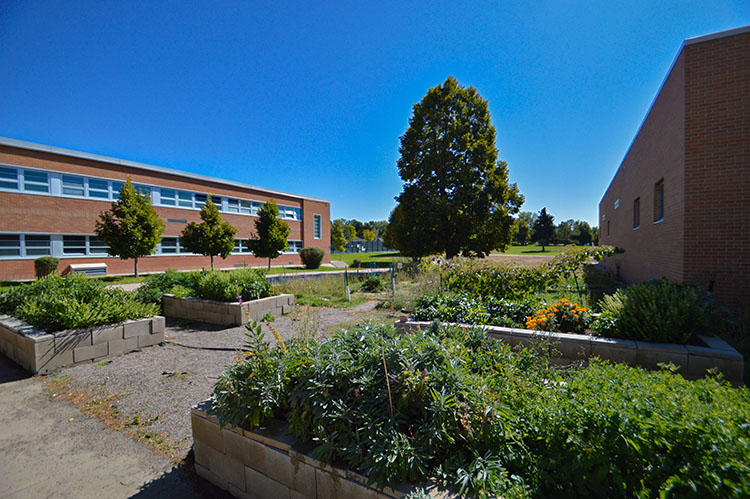
TJ provides students with the unique opportunity to earn work experience through growing and harvesting plants in the school garden. photo by AJ Domagala
Thomas Jefferson takes strides towards a new and improved garden.
Thomas Jefferson High School operates the largest garden in the Denver Public School District. Students attending TJ run the garden throughout the school year and the Garden of Youth program takes over during the summer. Unlike an ordinary garden, TJ students don’t just grow flowers for the aesthetic. When they grow, they gain life and work experience.
Terence Johnson, a junior at TJ, loves working in the garden. Besides fueling his love for planting, he is also learning valuable life skills. He says he’s always “learning to communicate with other people and also learning to share with people.” Additionally, TJ’s garden is part of a garden to cafeteria program, meaning that all the food that is grown is used to cook food for the students. “We could even give them green tomatoes and they would make green tomato salsa,” said Elizabeth Lynch, WES (Work Experience Study) Coordinator and AVID teacher. Lynch has been a part of the garden since it was started eight years ago. The garden has changed dramatically since it was first built. Last year, signs were implemented in the garden to educate students about the type of plants and how they grow. However, even with these improvements, there are still some major issues plaguing the TJ garden and its inhabitants.
Weeds are invading the plants in the garden, and anyone who knows about plants knows that they cannot coexist with weeds. Another major issue affecting the garden is the hoard of Japanese Beetles. “They love all the plants,” explained Johnson. The third major issue afflicting the garden is an infestation of wasps. Right now the garden utilizes cinder blocks in the beds, and while they are incredibly helpful to the structure of the garden, they make exceptional homes for the wasps. Lynch warns “If you really get close at the wrong time of day, you’ll get stung.” Between the weeds, the beetles, and the wasps, TJ’s garden needs some help. Luckily, the students and staff who tend to it have a plan.
TJ is hoping to apply for the Perkins Grant, which awards money to schools. In this case, the money would be used to make improvements to the garden. The hope is to create fifteen raised beds with benches surrounding them. This would eliminate the needs for cinder blocks and the wasp-favoring environment. In addition to the raised bench beds, there are hopes to create a park area around the garden so it could be enjoyed by students. Plans for a pavilion have also been considered. This pavilion would be used by Spartans as an outdoor classroom. With the money from the Perkins Grant, all these improvements could be made. This would provide a more gratifying experience for the students and staff who maintain the garden, as well as anyone looking to enjoy the district’s largest garden.
The updates to the garden will have several positive effects that go beyond student enjoyment. As mentioned before, all of the produce from TJ’s garden is used in the cafeteria. With an increase in bed size and numbers, more plants can be produced. More fresh homegrown fruits and vegetables will then be served to students in the cafeteria. In addition to an increase in production, the developments to the garden will allow TJ to employ more students through the Garden of Youth Program. This program teaches students not only about organic gardening, but also about life and work skills. The goal is to give as many teenagers the opportunity to gain these experiences as possible.
There are a lot of plans being made for TJ’s garden which can be expected soon. The target timeline is to have the grant written before the end of the 2019-2020 school year. That leaves the summer to focus on building and construction. Hopefully, students will be walking into a revived TJ garden by the start of next year!